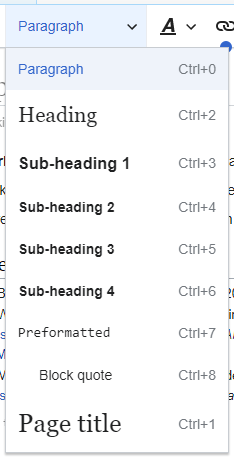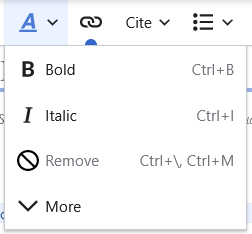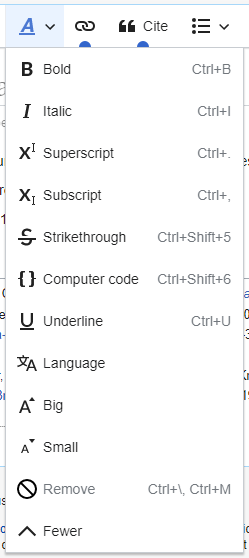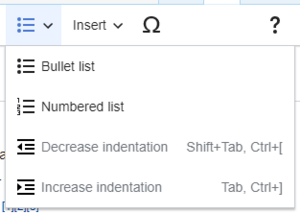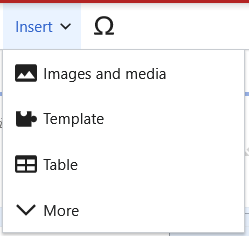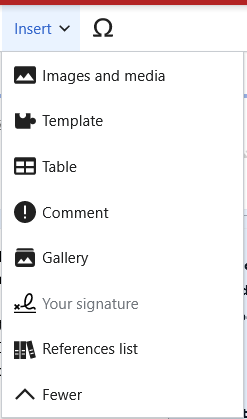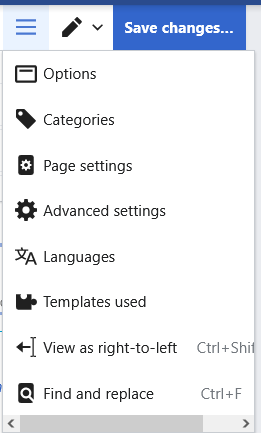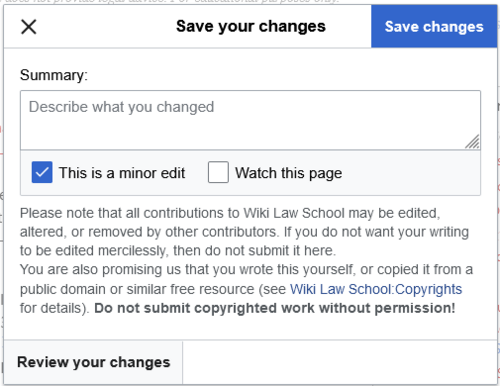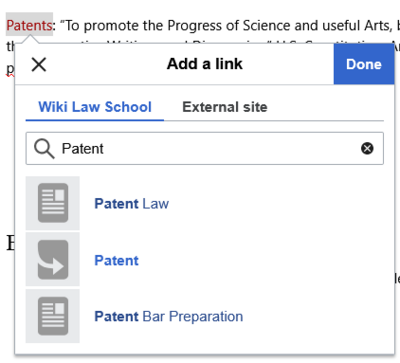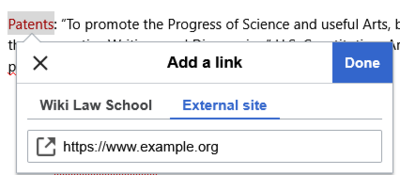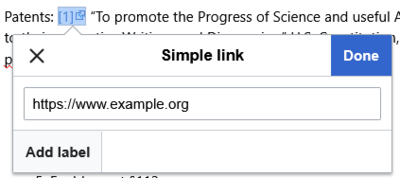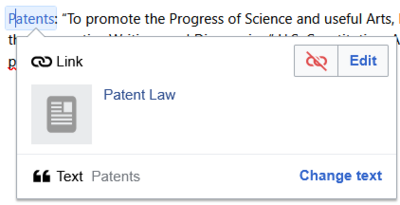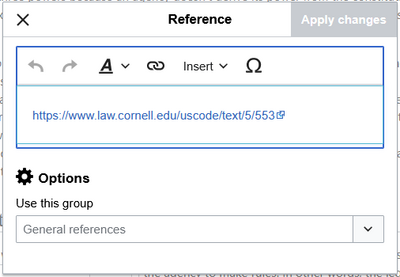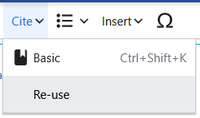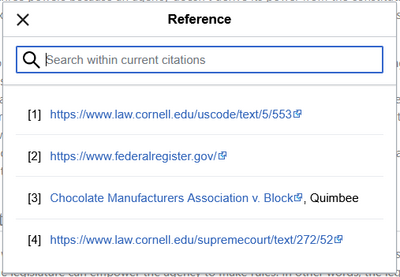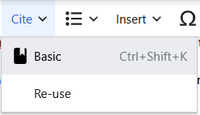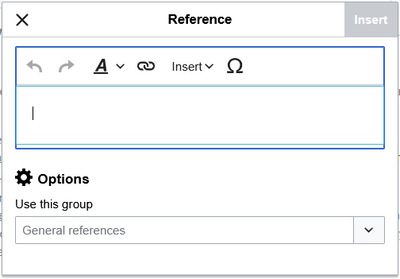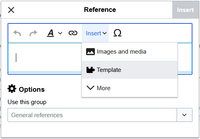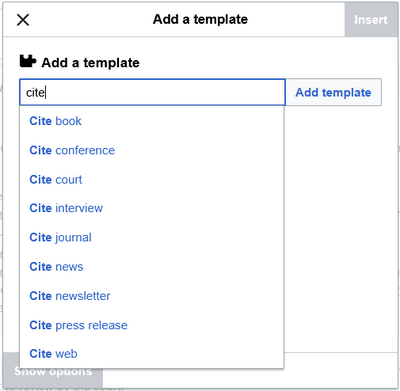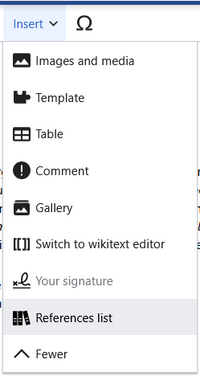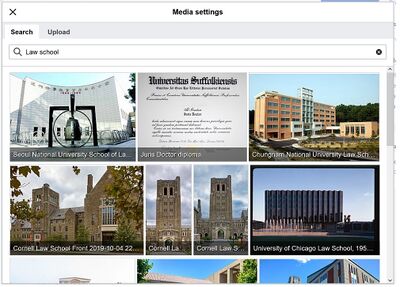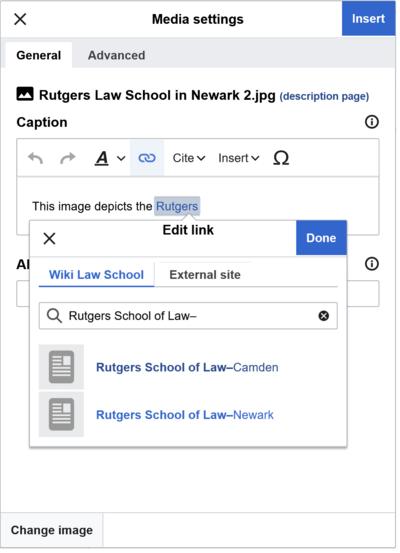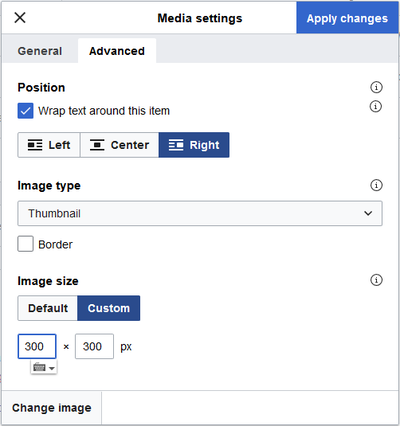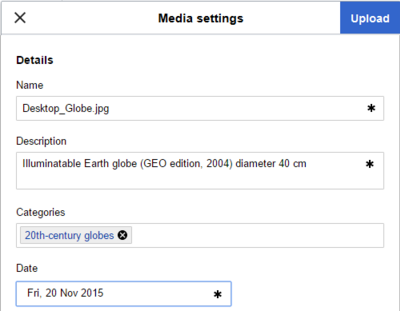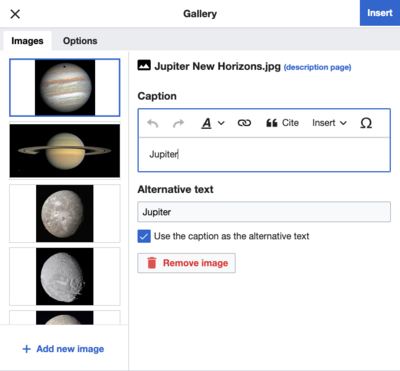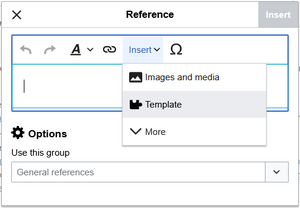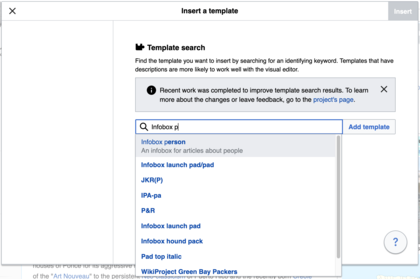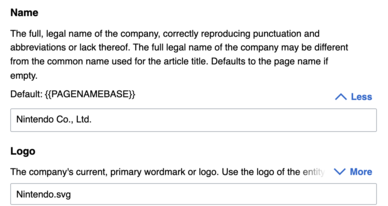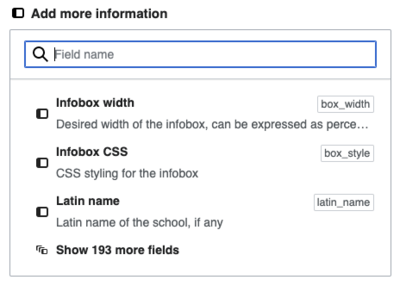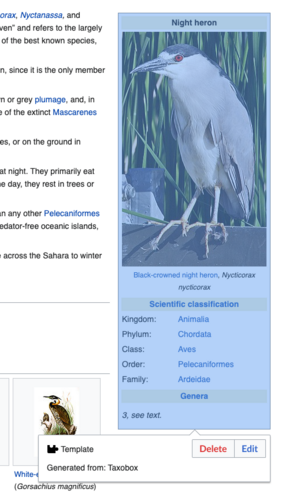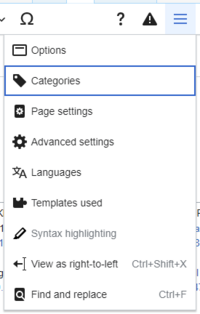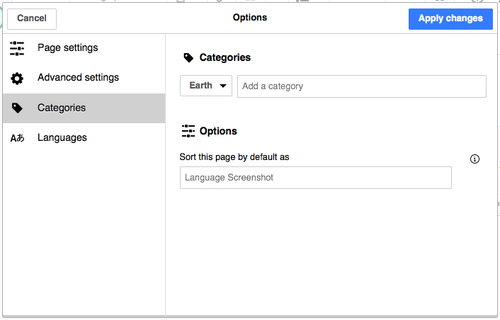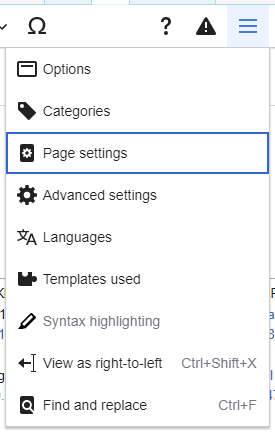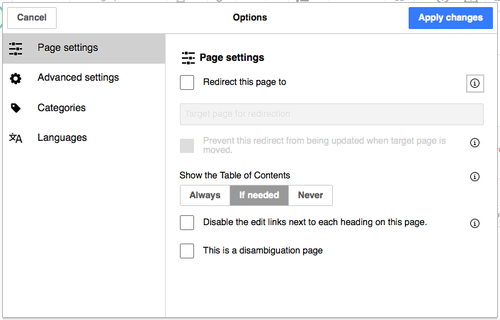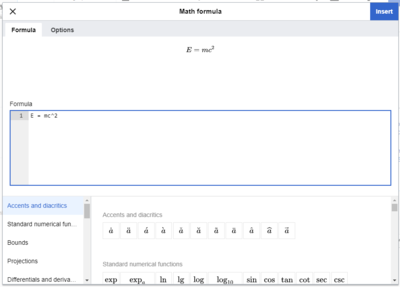Help:VisualEditor
Help Pages Table of Contents |
| Introduction |
| Reading |
| Navigation |
| Searching |
| Logging in |
| Notifications |
| Tracking changes |
| Page history |
| Watchlist |
| Editing |
| Editing pages |
| Starting a new page |
| Formatting |
| Talk pages |
| Structured Discussions |
| User page |
| Links |
| Categories |
| Advanced Editing |
| Footnote citations |
| Images |
| Tables |
| Transclusion |
| Templates |
| Moving a page |
| Namespaces |
| Variables |
| Managing files |
| Special pages |
| Deleting pages |
| Customizing |
| Preferences |
Opening the visual editor
| To edit a page using the visual editor, press on the "Edit" tab at the top of the page.
It may take a few seconds for the page to open for editing, and longer if the page is very long. Pressing on the "Edit source" tab will open the classic wikitext source editor. The "Edit source" tab is not available on all pages. |
|
| You can also open the visual editor by pressing on the "Edit" link on each section. | |
Getting started: the visual editor's toolbar
| The visual editor's toolbar appears at the top of the screen when you begin editing. It includes some familiar icons: | |
| Undo and Redo the changes you have made. | |
| Headings pull-down menu: allows you to change how the paragraph is formatted. To change the style of a paragraph, put your cursor in the paragraph and select an item in this menu (you don't have to highlight any text). Section titles are formatted "Heading", and subsections are "Sub-heading 1", "Sub-heading 2", and so on. The normal format for text is "Paragraph". | |
| Formatting: Pressing the "A" opens the formatting menu. Clicking "∨ More" expands it. Clicking "∧ Fewer" contracts it. | |
If you have not selected any text, when you press the "A" to open the menu, and then select a formatting item, that formatting will apply to the text that you start typing, from wherever your cursor is located. | |
| Linking tool: The chain icon is the linking tool. Pressing on it (usually after selecting some text) opens the link dialog. | |
| Cite menu: The "Cite" menu is used to add inline citations (also called "footnotes" or "references"). This menu gives editors basic reference formatting and the ability to reuse citations. It also gives users quick access to local citation templates. | |
| Lists and indentation: The first two items allow you to format text as either a "Bullet list" or a "Numbered list". The last two items allow you to decrease or increase the indentation level of list items. | |
| Pressing "Insert" opens the Insert menu. Clicking "∨ More" expands it. Clicking "∧ Fewer" contracts it. | |
| |
| Special character insertion: The "Special Character" (Ω) icon is next to the "Insert" menu. When pressed, it displays a dialog showing many special characters. By pressing on a specific character, you place it into the text. These special characters include some standard symbols that may be used in law-related documents. (This list may be customized locally. To suggest an additional special character, please visit MediaWiki talk:Visualeditor-quick-access-characters.json and start a new topic.) | |
| The Edit notices button displays any notices for the page. | |
The Page Options menu is to the left of the Save Changes button and the Switch editor menu. On this menu there is a button to open an Options dialog with the following tabs:
The tabs of the Options dialog are also displayed in the Page options menu and can be opened by clicking on it. Furthermore, the Page options menu contains the button View as right-to-left and the button Find and replace, which opens a dialog where you can insert characters, terms, or Regular expressions you are searching for and those to replace them with, together with several buttons for options. | |
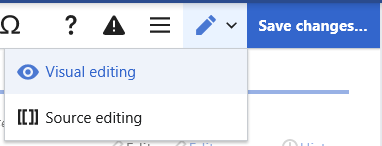
|
The switch to source editing button is next to the "Save Changes" button. It allows you to switch to the wikitext editor (for "Source editing") and back to the VisualEditor (for "Visual editing"). |
Publishing changes
| When you are finished editing, press the blue "Save Changes" button in the toolbar. If you have made no changes, the button will be disabled (grayed out). To cancel all your editing changes, close your browser window, or press the "back" button on your web browser. | |
| Pressing the blue "Save Changes" button opens a dialog. You can then enter a brief summary of your actions, mark your edit as minor, and/or add the page to your watchlist.
You can also review your changes using the "Review your changes" button to confirm that they will appear as intended before saving your changes. This is similar to the "show changes" button in the wikitext editor. The "X" button in the dialog's upper-left corner returns you to the page you were editing. You can save your changes later. |
|
Editing links
| Links can be added through the "Link" icon (links in a chain) in the toolbar, or by using the shortcut Ctrl+K (or ⌘ Command+K on a Mac).
If you select (highlight) text and then press the "Link" button, that text will be used in creating the link. For a link that involves only one word, you can either select that word or just put the cursor within that word. | |
| When you use either the button or the shortcut, a dialog will open in which you may type the link.
The link tool will try to help with internal links by searching for likely matches. Once you have entered or selected the link, you complete the linking process by pressing ↵ Enter or by pressing the "Done" button. Your link will immediately appear on the page, but as with other changes to the page, it will not be published until you publish the entire page (by selecting "Save changes"). | |
| To link to a web page on another website, the process is similar: Choose the "External site" tab, and enter a URL in the box. | |
| External links without labels look like this: [1]. You can add these by placing your cursor away from any word (e.g., after a space). Open the link tool by pressing on the button or pressing the shortcut keys. Type the URL in the box, and press the "Done" button to insert the link. | |
| To change or remove an existing link, press within the text for that link, then press the "Link" icon that appears near it. The dialog will appear, for editing. You can also get to the dialog with the Ctrl+K keyboard shortcut. When a link is selected, it appears as blue framed.
In the link editing dialog, you can then change where the link goes. You can also remove the link entirely by pressing the "Remove" button near the upper right corner of the dialog. You can also open the link's target in another window by selecting the link in the dialog box. (You may want do this to check if an external link is valid.) If you want to exit the link label (the text displayed as a link) or continue to write after this link, you can press →:
To edit the link label of an existing link, press within the link label and type the new one. But if you want to replace the entire label, please note:
| |
Editing references
Editing an existing reference | |
| To edit an existing reference, press on it where it appears in the text (usually as a bracketed number). You will see a "Reference" icon (bookmark). | |
| Pressing "Edit" opens the Reference dialog. To start changing the reference information, press on it.
If a template is used in your selected reference, then when you move your pointer over the reference information, all the information in that field will be highlighted. If a template was used and you press on the reference information, then the Template icon (puzzle piece) will appear with some information. Press on the "edit" button to edit the content of the template in the template mini-editor dialog. Press on "Apply changes" when you are done. |
|
Re-using an existing reference | |
| If the page already contains a citation that applies to the text you want to source, then you can choose to re-use that existing citation.
To re-use an existing reference, place your cursor in the body of the text where you want to add a new reference (number) for that citation. Then press on the "Re-use reference" item from the "Cite" menu. |
|
| In the Reference dialog, look at the list for the reference you want to reuse, and select it. If there are many references, you can use the search box (labeled "Search within current citations") to list only those references that include certain text. | |
Adding a new reference | |
| To add a citation using the "Cite" menu, place your cursor where you want to add it in the text. Then select the appropriate citation type in the menu (e.g., "Basic"). | |
Using the "Basic" citation | |
| Shown here is what you will see if you select the basic references item. In the Reference editor, you can add your citation, including formatting.
You can make the reference belong to a given group, although normally this is left blank. (This option is used to display groups of references with the "References list" tool.) |
|
| In the Reference dialog, if you want to include a citation template, or any other template, in your new reference, press the Template icon (puzzle piece) in the "Insert" toolbar menu within the Reference editor. | |
| Then, look for the template you want to use, add it and edit it as you would any other template. (See the Editing templates section, below, if you need more information about templates.)
After you are done editing your new template, press on "Insert" to return to the Reference editor, and "Insert" again to return to the page you are editing. |
|
| If there isn't already a list of references on the page (for example, if you are adding the first reference for the page), you need to specify where the list of references, and their text, will be displayed to the reader.
Place the cursor where you want to display the references list (usually at the bottom of the page), open the "Insert" menu and press the "References List" icon (three books). |
|
Editing images and other media files
Editing images | |
| To add a new image (or another type of media file) to the page, press the "Images and media" icon (a picture of mountains) in the "Insert" menu. The image will be added wherever your cursor is. | |
| Pressing the "Images and media" icon opens a dialog that automatically searches Wikimedia Commons and your local wiki for media files related to the title of the page you are editing.
You can change the search by changing the text in the dialog's search box. To choose a file, press on its thumbnail image. This places the image onto the page you are editing. You can change the search by changing the text in the dialog's search box. To choose a file, press on its thumbnail image. This places the image onto the page you are editing. |
|
| After the image you selected is inserted into the page, another dialog will open. This dialog allows you to add and edit the caption of the image. The caption can contain formatting and links. | |
| The media dialog also allows you to add alternative text captions, to help users who use screen readers, or who have disabled image display. | |
| You can also set various parameters for the image in the "Advanced settings" window. These include the alignment, the type, and size of the image. | |
| When you are done, press "Apply changes" to close the dialog and return to editing the page. | |
| For an existing image, you can add or edit a caption or other settings by pressing on the image, then pressing on the "Images and media" icon that appears below the picture.
You can resize an existing image by pressing on it, then moving the resize icon (the two-headed arrow on one or both bottom corners). You can also drag and drop an image to a place higher or lower on the page. |
|
Uploading images
| You can upload images from a tab in the media dialog, or by dragging and dropping a file into the editor, or by pasting an image from your clipboard. | |
| Press the "Upload" tab and select an image from your computer. You can type the file name, or drag an image into the box. If you dragged and dropped an image directly into the editor, or pasted one from your clipboard, this tab will open automatically. | |
| You need to describe the image and add categories to it so that other people can find it. | |
| The image will be inserted into the page when you are done. | |
Editing media galleries
| To add a new gallery, press the "Gallery" icon (a set of photos) on the "Insert" menu. | |
| To edit an existing gallery in the visual editor, press that gallery. Then, near the bottom of the gallery, press the gallery icon (a set of photos). This brings up the gallery editor, with the full list of images included in the gallery. | |
The gallery editor is currently a simple box that allows you to edit existing galleries using wikitext markup. To add a new image to an existing gallery, type the file name, followed by a bar (|) and the caption for that image. You must put each image in the gallery on its own line. You can also edit this list to remove or rearrange images or to change captions.
When you press the "Done" button, you will exit the gallery editor. You should then see your changes, with the gallery as it will now appear to readers. Remember that exiting the gallery editor does not publish your changes. As with other changes made using the visual editor, you must publish the entire page in order to publish your work. |
|
Editing templates
The powerful MediaWiki template system lets you insert dynamic content, text from other pages, and much more. For a detailed explanation and examples, see the [[<tvar name=1>Special:MyLanguage/Help:Templates</tvar>|Templates help page]].
In the VisualEditor you can search for a relevant template, add an invocation or [[<tvar name=1>Special:MyLanguage/Manual:Glossary#Transclusion</tvar>|transclusion]] on the page you’re editing and, if needed, add custom content using [[<tvar name=2>Special:MyLanguage/Manual:Glossary#Parameter</tvar>|parameters]].
Insert new template
| To add a template to a page, place your cursor at the position on the page where you want the template to be inserted. Then open the <tvar name=1>Template:Int</tvar> menu and select "<tvar name=2> |
|
| Find the template you want to insert by typing either its name or a relevant keyword. Results containing the search term in either the name or description will display in a dropdown. This should help you find a relevant template, even if you don’t know its exact name.
If you’re having trouble finding the kind of template you want by using keywords, you can look on other wiki pages with similar content and view or edit the page source to see which templates are in use. When you find the desired template’s name, you can type it into this field to insert it here. |
|
| You can also edit a template that’s already on a page. When you select the template you want to edit, it turns blue, and a box appears displaying "<tvar name=1> |
|
| Some templates are not visible to someone reading a page. In the visual editor, such hidden templates are still shown so that you can click and edit or delete them. The name of the template will be shown next to the puzzle icon and both will be grayed out. | |
|
Template parameters | |
| You’ll see this dialog box when you’re adding a new template or editing one already in place. What you see in the box depends on whether the template in question contains <tvar name=1>Template:Ll</tvar>, helpful metadata added by other editors to make it easier to edit templates in the Visual Editor.
For templates that have some community-provided TemplateData, the VisualEditor displays a list of the named parameters and, often, descriptions and instructions explaining the meaning and required format for each parameter’s values. |
|
| For an existing template, you can edit the parameters shown in the dialog, and you can add parameters by pressing "<tvar name=add-param>Template:Int</tvar>", at the very bottom of the dialog. | |
|
Adding undocumented parameters | |
If you’re inserting or editing a template whose author hasn’t laid out its parameters in TemplateData, it has what we call “undocumented” or “unnamed parameters”. In these cases, you should consult the page for the template itself. There you can learn how to correctly employ and work with all of the template’s parameters. This includes learning the exact names of the parameters as written by the template author.
If you find in the documentation that the template expects parameters without have names, fill in numbers as placeholders for the parameter names using the undocumented parameter input, then add next to the values you want to provide as you normally would. Example: * first unnamed parameter: “1” * first unnamed parameter’s value: “en_US” * second unnamed parameter: “2” * second unnamed parameter’s value: “yes”
|
|
|
Autogenerated parameters | |
| In this example, the template in question lacks TemplateData but it was possible to autogenerate the parameters. This means that the undocumented parameters have already been added for you, but the names may not be easily understandable and the dialog cannot display any directions or descriptions. As a result the dialog box provides a link to the template’s documentation, which should help you deduce and fill in the template’s various parameters. | |
|
Editing multi-part template content | |
During editing, you may open template content consisting of multiple templates or a single template linked to some wikitext. This differs from the nested templates described below. In this case, the templates are better visualized as being stacked or connected.
This content often contains “unbalanced templates,” templates which are incomplete on their own and need to be paired with some wikitext or another template in order to function. |
|
Nested templates | |
Templates can include other templates as the value for parameters. You’ll recognize it when you see a parameter whose value contains the double curly braces ( {{ }} ) denoting a template.
The VisualEditor can’t present this template within a template (a nested template) using the editor’s easy-to-use interface, so if you want to nest a template yourself, you’ll need to understand how to add the template by hand in wikitext into the appropriate parameter field. |
|
Completing your edit | |
When you have finished editing a template, you can click "<tvar name=apply>Template:Int</tvar>". Then you can preview your edit and make sure it looks the way you want and expect.
You may also see an error message, which (like the other TemplateData mentioned above) is community-provided content and may vary in usefulness. You may need to consult the template’s own documentation to get to the bottom of some errors. If you’re still having trouble, consider posting about your problem on the template’s talk page. |
|
Removing a template | |
| To remove a template in the VisualEditor, click the template box. A context menu will appear with a "Delete" button. Click it to remove the template from the page. | |
Editing on mobile | |
| When editing a template on a page using the VisualEditor on a mobile device, you’ll see that the sidebar starts out hidden. You can make it visible by pressing the “Show/hide options” button. | |
Substituting templates | |
When you insert a template in a wiki page, its content and appearance are reevaluated every time the page loads, based on the template code and the values of its parameters. This means if someone updates the code of a template, then every page which uses that template will also get updated when they publish.
There’s another, much less common way to use templates, though, and that’s to substitute a template. Doing this permanently includes the template content just as it appears at the moment you insert it. It will not update if the template code is later changed. Most users won’t ever need to resort to substitution. Substitution is typically only useful when you need to capture the exact appearance of one version of a template, such as when content is under development and needs evaluation. To substitute a template in the VisualEditor, insert a template using the name syntax
|
|
Editing lists
You can use the visual editor to create lists, or to change the format of an existing list. There are two types of lists: unordered (bullet) and ordered (numbered).
To start a new list, just press on one of the two menu items shown here. Or, if you already have typed the list (on separate lines), select (highlight) the list you have typed, then press on one of the menu items. | |
| Shown here are examples of the two types of lists: unordered (bullet) and ordered (numbered). | |
| If you want to change the indentation level of part of an existing list, select the part of the list that you want to change. | |
| Then use the menu, or press the Tab key. (The Tab key increases indentation; use the shift key plus the Tab key to decrease indentation) | |
| Here is the result of increased indentation. | |
| You can even mix ordered (numbered) and unordered (bullet) lists, if the list items have different indentations. | |
Editing tables
You can use the visual editor to insert and change tables.
You can even import a table by dragging a comma-separated value (.csv) file from your computer into the main editing window. | |
When you press on "Table", in the "<tvar name=toolbar>Template:Int</tvar>" menu, the visual editor inserts a blank four-by-four table.
Now the "Table" menu is available. From that menu, you can add a caption to the top of the table. |
|
| To select a cell, press it once. | |
To edit the contents of the cell (for example, to add content or to correct a spelling error), double press in the cell. Or you can select the cell and then press Return.
To end your editing of a cell, just press elsewhere. |
|
| You can add, move or delete a column or a row. | |
| You can merge cells: Select them, then from the Table menu, press on "Merge cells". | |
| If you merge cells, only the text in one cell is kept; any text in the other cells is deleted when you merge the cells. If you decide that you wanted some or all of the text that was deleted, use the Undo button, move or copy the text you want, then merge the cells again. | |
| You can also split cells that were previously merged. All the content that was in the merged cell will remain in the first cell when you do the split. You can then cut and paste text to other cells, if you want. | |
Editing categories
| To edit categories, on the "<tvar name=pagemenu>Template:Int</tvar>" menu, press the "<tvar name=categories-tool>Template:Int</tvar>" item. | |
| Pressing on "<tvar name=categories-tool>Template:Int</tvar>" opens a dialog that lists existing categories and allows you to add new ones, and to delete existing categories.
For example, the default sorting key for the article "George Washington" is "Washington, George". In the category "Presidents of the United States", the article is listed under the letter "W", not the letter "G". | |
| To add a category for a page, type the name of the category into the field "<tvar name=apply>Template:Int</tvar>". As you type, the visual editor will search for possible matching, existing categories. You can either select an existing category, or you can add a category that doesn't yet have its own category page. (Until that category page is created, your new category will show as a red link after you publish all your editing changes.) | |
To remove an existing category, press on it and press on the "<tvar name=remove>Template:Int</tvar>" icon (trash can) in the dialog that opens.
Pressing on a category also allows you to specify a sorting key for that specific category. Such a sorting key overrides the default sorting key. | |
| Press "<tvar name=apply>Template:Int</tvar>" when you are done editing categories to return to the page editor. | |
Editing page settings
| To edit a page's settings, press to open the "<tvar name=pagemenu>Template:Int</tvar>" menu, in the toolbar, and select the "<tvar name=page-settings>Template:Int</tvar>" button. | |
| The "<tvar name=page-settings>Template:Int</tvar>" button opens a dialog that shows several options. | |
You can make a page a redirect to another page by checking the "<tvar name=redirect-label>Template:Int</tvar>" checkbox, and then typing the name of the page to which you want to send the reader who tries to go to the page that you are editing.
At the bottom is the option to prevent page renames from updating this redirect. This is very rarely used. | |
| You can change whether the page shows a Table of Contents by selecting one of these three buttons. The default option is "<tvar name=toc-default>Template:Int</tvar>", which shows a Table of Contents if there are three or more headings. | |
| You can make a page not show edit links next to each section header by checking this checkbox. | |
| Press "<tvar name=apply>Template:Int</tvar>" when you are done editing the <tvar name=pagemenu>Template:Int</tvar> to return to the page editor. | |
Editing maps
| You can add and change maps. See <tvar name=1>Template:Ll</tvar>. |
Editing mathematical formulae
| To add a new mathematical formula to the page, place your cursor where you want it to be inserted, and press on the "<tvar name=formula-title>Template:Int</tvar>" icon ("Σ") in the "<tvar name=insert>Template:Int</tvar>" menu on the toolbar. | |
| A window will open in which you can type the formula, using LaTeX syntax. the visual editor will update the formula as you type it, so you can see how it will look as you make changes. Once you are happy with the formula, press the "<tvar name=dialogdone>Template:Int</tvar>" button. | |
| To edit an existing mathematical formula on the page, press on it and then press on the "Σ" icon that appears. This will open up the formula window, where you make changes. | |
| Mathematical formulae can be placed inline or centered as a block. | |
Editing musical scores
| To add a new musical notation to a page, place your cursor where you want the musical notation to be inserted. Then, from the "Insert" menu on the toolbar, press the "Musical notation" option.
|
|
| This will open the "Musical notation" dialog. Here the notation can be edited by scale, either in ABC or in Lilypond format. You can also link the notation to an audio or MIDI file. Once you are finished, press the "Done" button to close the dialog and publish your changes. | |
Editing poems and other special items
| Some items, such as association lists and poems, are not yet fully supported by the visual editor. | |
In most cases, the existing items can be edited, but new ones cannot be inserted in the visual editor.
Until they are fully supported, you can copy an existing one from another page, or edit the source wikitext directly. |
|
Switching between the visual and wikitext editors
To switch from the visual editor to the wikitext editor, press the <tvar name=1>
|
|
You'll see a diff. (If you pressed on "Discard changes", you'll just see wikitext, ready to edit with the wikitext editor.)
Scroll down, and you'll see the wikitext editing area. |
|
You can also switch from the wikitext editor to the visual editor. To do that, press the pencil icon on the far right of the toolbar. |
|
Keyboard shortcuts
Many editors are used to entering wikitext directly, especially bold, italics and wikilinks. [[<tvar name=Keyboard>mw:VisualEditor/Portal/Keyboard shortcuts</tvar>|Keyboard shortcuts]] allow to quickly insert similar formatting without having to use toolbar items. Here are the common general shortcuts in the visual editor:
| PC shortcut | Action | Mac shortcut |
|---|---|---|
| Ctrl+B | Bold | ⌘ Cmd+B |
| Ctrl+I | Italics | ⌘ Cmd+I |
| Ctrl+K | Insert link | ⌘ Cmd+K |
| Ctrl+X | Cut | ⌘ Cmd+X |
| Ctrl+C | Copy | ⌘ Cmd+C |
| Ctrl+V | Paste | ⌘ Cmd+V |
| Ctrl+Z | Undo | ⌘ Cmd+Z |



